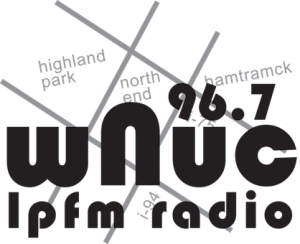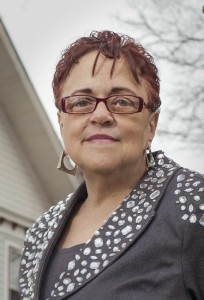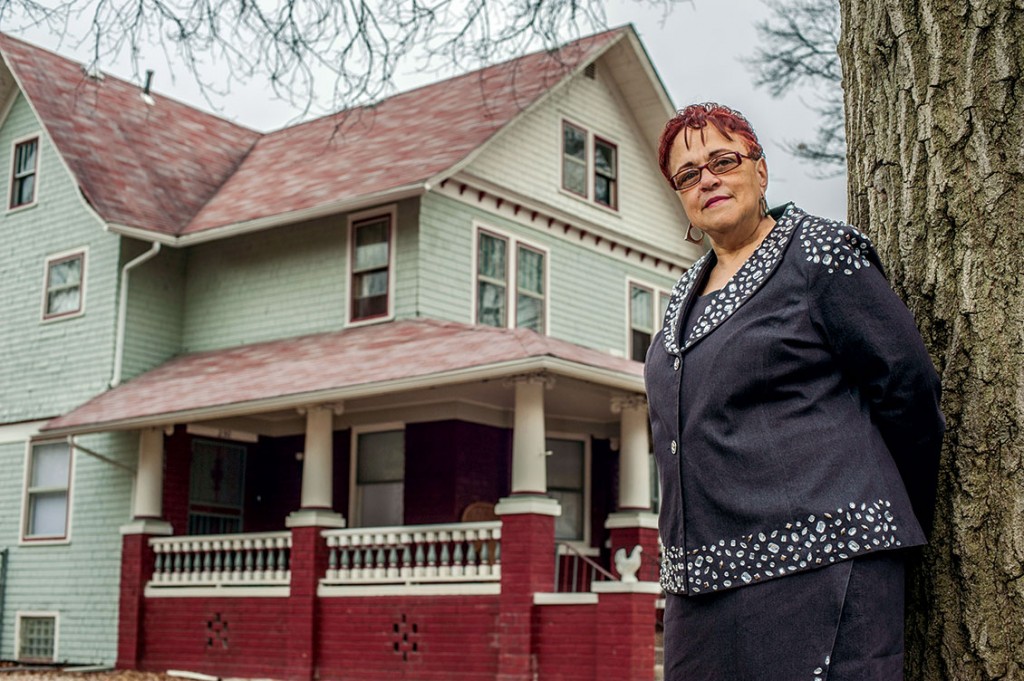 Come Thanksgiving, WNUC 96.7 LPFM will go on the air, and the people of Detroit will gain a powerful tool.
Come Thanksgiving, WNUC 96.7 LPFM will go on the air, and the people of Detroit will gain a powerful tool.
Reverend Joan Ross—Acting Station Manager and Director of the North End/Woodward Community Coalition (NEWCC), the station’s license-holder—says, “North End Uniting Communities—NUC, that’s what our call letters stand for. We hope this is the jump-point, that communities from all over the city will unite around this piece of communication, voice, and power.”
Ayana Rubio, Ross’ assistant and the young heart of the initiative (Ross and Rubio joke, “We don’t have titles, and we don’t have any money”), adds, “What is really exciting is that, because people are so disconnected by inadequate transit, and because Detroit is such a big city, and because segregation here has had such a strong and continuing legacy, there are a lot of neighborhoods that aren’t connecting except in these tiny one-on-ones. We’re looking forward to people getting together from different parts of the city, working together, in ways that they haven’t been able to.”
That mission, Ross points out, has been the driving force behind the station from its inception, a natural extension of her work as Chairman of the Board at Detroit’s Storehouse of Hope, an emergency food pantry that provides wrap-around services to 3,000 households, and of NEWCC’s long-time advocacy of transit justice.
“When we started the Coalition, we discovered that there were mothers who needed our pantry services who couldn’t get back and forth to work,” Ross says. “We have no buses running in Detroit between 9:00 at night and 6:00 in the morning. So, if you have a job working the middle shift or the midnight shift, you can’t get to work or you can’t get home from work.”
 NEWCC, a community coalition of faith-based organizations, businesses, and residents, formed in response to the 2011 defeat of a proposal to create a Woodward Light Rail system that would have remedied this situation, connecting job centers from Detroit to Pontiac. The project failed because of politics in various surrounding counties, counties through which the rail system would have had to pass.
NEWCC, a community coalition of faith-based organizations, businesses, and residents, formed in response to the 2011 defeat of a proposal to create a Woodward Light Rail system that would have remedied this situation, connecting job centers from Detroit to Pontiac. The project failed because of politics in various surrounding counties, counties through which the rail system would have had to pass.
“These out-suburb counties fight Detroit primarily as a racial issue,” Ross says. “For us, it was L. Brooks Paterson, County Executive in Oakland, who said over his dead body.”
In its place, in 2012, Detroit began construction on a $150 million streetcar project, a for-profit project funded by both private and public investment. Ross says, “Yes, it is a streetcar! It only serves 3.3 miles of roadway at a speed of 11 miles per hour. If you are in good health and don’t eat pork chops, you can walk next to it faster than it can go. It’s an economic development toy for the rich and the famous.
“The line does not connect people to job centers. It doesn’t make any connections at major transit hubs. It only goes into midtown and downtown, so, even if you’re on a bus, you have to get off the bus and get on the streetcar. It’s going to come into the North End, turn around in the North End, but it will not allow North End people to board it. If you’re older, or physically challenged, or a mom with six babies pulling on you, how do you walk several blocks into another area to get on something that stops right in your area? We see that as a social justice issue, a transit justice issue, which has all kinds of racial overtones. If you are in the North End, isn’t money still green no matter where you’re getting on the streetcar?”
The new station’s local programming has already been substantially designed with these issues and objectives in mind. “We’ve got two or three really unique programs,” says Ross.
The centerpiece of the station’s programming will be a cross-collaboration among the city’s many issue-engaged organizations. The station has grouped together local organizations that share common concerns, and each coalition will produce one weekly program, serving as rotating hosts. For example, Detroit’s ten transit groups are preparing a program called Moving Detroit, while the environmental coalition is creating a program tentatively called Green Detroit.
Ross says, “This is a really different structure for us. Usually, people can be working on the same issues but not talking to each other. Here, every week, listeners can tune in to that one show with one general theme.”
Transit justice, in many ways, will remain as a central focus for NEWCC, and Moving Detroit’s innovative programming reflects that intention. Last year, NEWCC received a grant to mount ten outdoor lights in an area where the city had turned off street lighting and where people had to walk to and from a bus stop along pitch black streets.
For a radio segment entitled Riding on the DDot, Ross says, “We want to do on-the-street and on-the-bus interviews. Often the county executives say that they get on the bus and don’t have any problem. But they don’t ride the bus every day, and they don’t have to get somewhere at 9:00 at night.”
“Radio to the Future” is the station’s initiative to bring young people, ages 10 to 22, into radio production. From 3:00-5:00 PM each afternoon, these freshly trained students will take over the airwaves. Since June, they have met weekly in small groups, preparing to serve as broadcasters and hosts. Rubio says, “This whole summer has been a combination of media literacy, honing listening skills and looking at the rhetoric that they’ll encounter, before they go on to craft the messages they want to deliver.” Recently, these students conducted their first on-site interviews at the Great Lakes Detroit Bioneers Conference, interviews that will be broadcast once the station goes live. Further, the plan is to equip participants with headsets and recorders allowing them to record in their schools.
Rubio adds, “We know that no one group of youth is going to be able to come every day from 3:00-5:00 to produce the show, so we’re looking to involve youth groups from all over the city, groups that might have a media project that doesn’t have an outlet.
This is handing people that megaphone that they’ve been missing. We want to make sure that kids are acquiring skills and that there’s a functional way that they can take on their concerns using them.”
Reverend Ross will host what will be the station’s first program, a program called My Block, My Hood, My City. Her plan, she says, is “to be all over Detroit, on the ground, with organizations and block committees, uniting communities, really telling the story of the impact that politics is having on community life and how communities are rising above those situations.”
Program content is already defined. “There are so many social justice issues in Detroit right now, lots of issues on the ground that we’re fighting. We have thousands of people’s water being shut off every week in Detroit. Many of them are mothers, families with children, and most of them are people of color, women who are absolutely struggling. Houses are being foreclosed.”
“Storehouse of Hope is right now participating in a tax auction in which some 40,000 properties are being sold. We are trying to purchase some of those homes and save those families by forming Detroit’s first community land trust.”
The station’s North End location means that its programming will be heard by over 300,000 Detroit residents as far as southwest Detroit; and, Ross points out, “The North End is the next frontier. Even though we’re close to the heart of all that you hear great happening in Detroit, we’re just as jacked up and messed up as any other place in urban America right now because of the disinvestment and the investment for the past 40 years into downtown and midtown Detroit. Nothing has happened in communities of substantial quality. We’re including all of those populations in our programs, all of those communities.”
Rubio says, “People are really excited. I’m from the Spanish-speaking community and people are excited to hear morning news that covers political interests from the ground up in Spanish; that is something that doesn’t exist in Detroit right now. People are excited to come in and volunteer and excited for the skills development component of this. It takes a high level of education to get in the door for an internship and many people don’t have access to learning opportunities. When we intake community members for engagement, we don’t only look at the station’s needs but also at what skill sets the volunteers are looking to build and how we can partner to make that happen.”
Right now, Ross and Rubio, are busy preparing for the station’s live launch. Studio space has been acquired on the fifth floor of an office building. Furniture is being made; equipment is expected by the end of October. The antenna, specially designed to suit the station’s location, arrives on November 17 and will be positioned by the end of that week. Rubio is organizing a spaghetti dinner—with entertainment and a silent auction—to be held the first week of November; funds will go directly to construction of the station’s public recording and broadcast studios.
Ross says, “The idea is to get a signal and then do whatever building we have to do. This is something that has been long in my heart. People don’t have power here because they’ve taken our voice away. There’s no station that covers our story. I think that, once we give power by voice back to people, if we have power and voice, we can see the vision and make the vision plain for everyone to understand. Communities are rising to the challenges. We don’t need the Black Hawk helicopters to land with some great white hope. We’ve got hope. We just need to get a message across. We’re thinking nothing but good weather from here on.”



